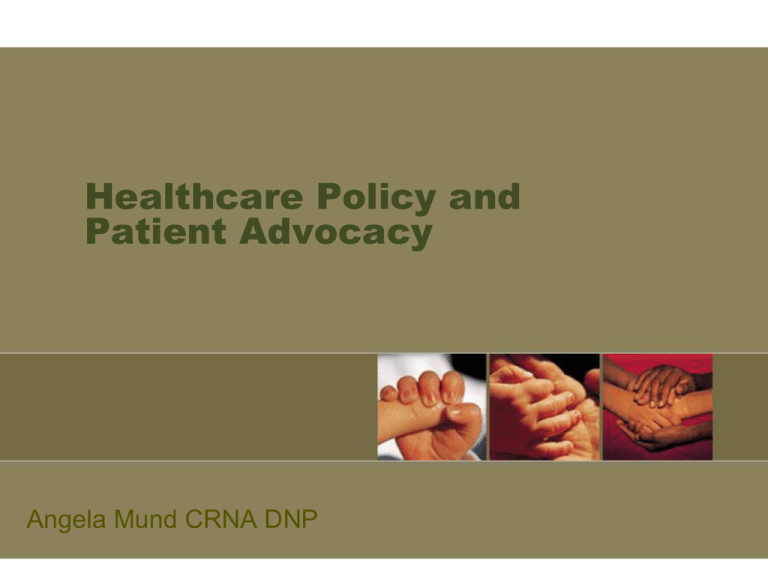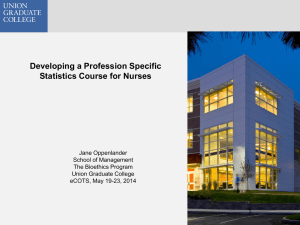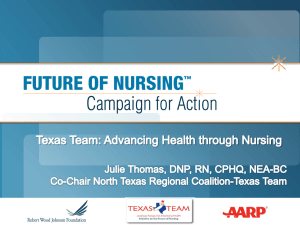Nursing and Policy - Association of Veterans Affairs Nurse Anesthetists
advertisement

Healthcare Policy and Patient Advocacy Angela Mund CRNA DNP Objectives • Discuss the history of nursing and policy • Compare and contrast policy and politics • Describe the policy process and areas for personal involvement • Discuss the current literature as related to health policy History of Nursing and Policy Making • Florence Nightingale – Parliament and The Crimean War • Lillian Wald and Lavina Dock – Licensure and Rights to Healthcare Advent of Advanced Practice Nursing Historical Aspect • 1970’s-Department of Health, Education, and Welfare – Committee to Study Extended Roles for Nurses • 1980’s – Tax Equity and Fiscal Responsibility Act of 1986 • Medicare IG search into fraudulent billing practices – Cost containment, Prospective Payment System 1983 • Bundled payments based on DRGs • CRNA services became practically unreimbursable – Consolidated Omnibus Budget Reconciliation Act of 1986 What are the legislative and regulatory challenges that are occurring now? Medicare • Medicare Part A: Payments to hospitals, ASC, etc • Medicare Part B: payment regulations for healthcare providers who are eligible to receive direct reimbursement – Provisions for medical supervision • greater than 4 concurrent cases: MDs 3 base units plus 1 additional base unit if present for induction – Provisions for medical direction • TEFRA requirements 7 conditions of payment • According to HCFA not a quality of care issue but elements of an anesthetic that an MD should be present for if they want to get reimbursed AANA continuing to follow and advocate for changes to outdated, inefficient TEFRA requirements for payment Cost and Efficiency AANA Federal Supervision Requirements • Medicare Part A • November 13th, 2001 – After consultation with stakeholders, each state Governor can send a letter to CMS requesting exemption from federal supervision • 17 states have “opt’ed out” Chronic Pain Management • Medicare authorizes payment under Part B • Medicare administrative contractor refusing payment • Role of the Federal Trade Commission and Hospital Associations • Battles in Louisiana, Oklahoma, Missouri and Iowa IS THERE A DIFFERENCE BETWEEN POLICY AND POLITICS? How are nurses and policy related? • Impact of policy on nursing practice • Impact of policy on patient care • Impact of policy on national and global health • Impact of policy on politics (legislative and regulatory) Professional Responsibility Never doubt that a small group of thoughtful committed citizens can change the world. Indeed, it is the only thing that ever has.” Margaret Mead AANA Code of Ethics • 6.4 The CRNA participates in research activities to improve practice, education, and public policy relative to the health needs of diverse populations, the health workforce, the organization and administration of health systems, and healthcare delivery. • 3.3 The CRNA participates in activities that contribute to the ongoing development of the profession and its body of knowledge Basic Policy Elements 1. Reviewing Policies includes studying formal decisions and actions 2. A policy may include a network of interacting decisions rather than a single decision 3. Policies change over time 4. Review policies that were not acted on 5. Identify policies created out of clear decision-making to develop an effective process of policy making Ham, et al 1992 Influencing Policy • Prepare, Prepare, Prepare • Speak the language of legislation and regulation • Understand committee structure • Ask the Ask! Movement of Legislation (in brief!) • Drafting of legislation • Bill introduction (first reading) • Referral to appropriate committee • Floor Vote Congress Executive • Bill sent to Governor or President • Veto Process or • Bill becomes Law • Law is sent to appropriate regulatory agency • Interpretation of law into rules and regulations Agency The political process is rarely rational, linear, or expeditious Just take a look at attempts for Health Care Reform! S.252 Title: A bill to amend title 38, United States Code, to enhance the capacity of the Department of Veterans Affairs to recruit and retain nurses and other critical health-care professionals, to improve the provision of health care veterans, and for other purposes. Ten Commandments 1. The Personal is Political SERENDIPITY! 2. Friends come and go but enemies can accumulate 3. Politics is the art of the possible MAJORITY RULES! 4. Be polite, be persistent, be persuasive WRITE, CALL, VISIT, WRITE, CALL VISIT… Ten Commandments 5. Talk to strangers 6. Give early and often 7. Take credit and control (What is the role of the PAC?) Ten Commandments 8. Politics has a chit economy 9. Reputations are permanent DEPENDABILITY 10. Don’t take it personal BEST OFFENSE IS A GOOD DEFENSE Tips for Lobbying • Be Prepared • Be Precise • Be a professional Tips for Lobbying • • • • Communicate Drive the Discussion Cultivate Relationships Lobby in person or on paper Advocacy at Political Action Committees • Pay to Play • The role of the Lobbyist • Bipartisenship – How do I know who is getting my money? • Do PAC’s influence legislation? • Reporting Healthcare PAC Contributions 2012 Cycle • American Association of Nurse Anesthetists came in 18th • 44,000 members (including students) • The ANA came in 17th – Represents over 3 million nurses • Only other nursing PAC to make top 100 – American College of Nurse Midwifes • 12,000 members AANA Levels of Giving to the PAC • Presidential Club • Congressional Club • Capital Club Open Secrets How can you become involved? • Local Politics • State Level – Committees and State Boards • Federal Level – AVANA Committees – AVANA Board • What are some challenges you experienced in your practice that could be impacted by changes in legislation or regulation? • How can you use the some/all of the political strategies to create influence? Areas for Involvement • • • • • Nursing Workforce Development (Title VIII) Reimbursement Health Care Reform Patient Access to Providers Nurse Practice Acts Barriers to Involvement • • • • • • Time Money Education Fear Lack of leadership/mentoring Initial disillusionment What components do you think would be useful? Power is an inevitable part of human interaction, and those persons, including nurses, who deny this fact will be at a serious disadvantage when trying to make change Kalisch &Kalisch, 1982 POWER • Numbers – Role of the professional organization • VOICE Of NURSING! • Expert power • Public Respect and Admiration – Use the Media As patient advocates we cannot be spectators or sideline shouters We must affect change through discussion, debate, analysis, and research in a positive proactive manner C. Bettin, AANA Senior Director of Commincations Rewards of Advocacy • • • • Personal Satisfaction Professional Satisfaction Sense of Accomplishment Sense of Control over patient outcomes Nurses have the skills to be successful at influencing policy • Negotiation and communication • Problem solvers • Management of challenging personalities and conflict • Team players – Building Coalitions Nursing Leadership from Bedside to Boardroom: Opinion Leaders Perceptions Robert Wood Johnson Foundation Survey (2010) Barriers to Nurses’ Ability to Contribute to Improvements in Planning Policy Development, and Management of Health Systems and Services Question Wording: Please tell me if you think each of the following is a major barrier, a minor barrier, or not a barrier to nurses’ ability to contribute to improvements in planning policy development, and management of health systems and services? Not Important Decision Makers Doctors as Revenue Generators How to Ensure That Nurses Take on More Leadership in Improving Health Status and Delivering Healthcare Services Question Wording: What, if anything, do you think could be done to ensure that nurses take on more leadership in improving health status and delivering healthcare services in the United States today? (Open-end question; Percent shown) What will be impact be of the IOM Report on the Future of Nursing and the APRN Consensus Document? Recommendations of the IOM Report • Nurses should practice to the full extent of their education and training • Nurses should achieve higher levels of education and training through an improved education system that promotes seamless education progression Recommendations of the IOM Report • Nurses should be full partners, with physicians and other healthcare professionals, in redesigning healthcare in the United States • Effective workforce planning and policy making require better data collection and an improved information infrastruture APRN Consensus Model • National Council of State Boards of Nursing • Ensure patient safety and expand patient access to APRNs • Standardization • 4 essential elements: – Licensure, accreditation, certification, education (LACE) APRN Consensus Model • Services or care provided by APRNs not defined or limited by setting but rather by patient care needs • What does this mean for us? Licensed Independent Pracitioners • • • • Consensus Model as Framework; IOM Recommendations All APRNs must be LIPs Privileges granted through Medical Staff Board However…”APRNS will practice within the privileges that are granted at the local level by the Professional Standards Board? • Timing of Full Implementation • Does your facility have a CRNA on the APRN Committee? Coalition for Patients Rights • Maureen Shekleton Professional Relations Specialist American Association of Nurse Anesthetists • > 35 Member organizations (diverse group) • State Action Coalitions • Offset the AMA SOPP initiative – Limits patients’ choice of providers – Attempts to define the SOP of CRNAs Patients’ Access to Responsible Care Alliance (PARCA) • Provide Access to information for Legislators • Nondiscriminatory language for reimbursement in healthcare reform legislation- SUCCESS!!! Is there an optimal time to study health policy? Model for Teaching Healthcare Policy • Information • Commitment • Initiative • Involvement Educators will need to demonstrate the relevancy of policy to practice Maynard (1990) Political Influence: a Model for Advanced Nursing Education Health Care Policy for Advocacy in Health Care (DNP Essential #5) “The DNP graduate integrates practice experiences with two additional skill sets: the ability to analyze the policy process and the ability to engage in politically competent action” (AACN) “Nurses will not be effective in politics and policy making until they value their voices, develop policy agendas that embrace their core values, and learn the skills of policy making and influencing” – Peters Is there an optimal route for nurses to study health policy? Lobbying in Washington DC Is there a role for a nursing specialty in Health Care Policy? What kind of degree would be required/needed? Health Policy and Research • Nursing Research – Supply the data and background information for creating policy • Policy Research – Analysis of the problem, provide alternative recommendations for future initiative No Harm Found When Nurse Anesthetists Work Without Supervision By Physicians Brian Dulisse and Jerry Cromwell Health Affairs, 29, no.8 (2010):1469-1475 Cost Effectiveness Analysis of Anesthesia Providers Paul F. Hogan Rita Furst Seifert Carol S. Moore Brian E. Simonson NURSING ECONOMIC$/May-June 2010/Vol. 28/No. 3 Influence of Supervision Ratios by Anesthesiologists on First-case Starts and Critical Portions of Anesthetics Richard H. Epstein, M.D., C.P.H.I, M.S.,* Franklin Dexter, M.D., Ph.D.† Anesthesiology, V 116 • No 3 March 2012 “If nurses want to be sought out as health care resources and have their views reflected in health care policy, Nurses have to get off the porch to run with the big dogs” -Mary Wakefield RN PhD References • • • • • Abood, S.(2007). Influencing health care in the legislative arena. Online Journal of Issues in Nursing. Aroskar, MA. Molodow, DG & good, CM (2004). Nurses’ voices: Policy, politics and Ethics. Nursing Ethics, 11(3), 266-276. Boswell, C., Cannon,S., & Miller J. (2005). Nurses’ political involvement: Responsibility versus Privilege. Journal of Professional Nursing, 21(1), 58. Kalisch, BJ & Kalisch, PA. (1982). Politics of Nursing. Philadelphia: JB Lippincott Peters, RM (2002). Nurse Administrators role in Health Policy: Teaching the Elephant to Dance. Nursing Administration Quarterly, 26(4), 1-8. References • • Twedell, D. & Webb J. (2007). The Value of the Political Action Committee: Dollars and Influence for Nurse Leaders. Nursing Administration Quarterly, 31(4), 279-283. Whitehead, D. (2003). The health-promoting nurse as health policy career expert and enterpreneur. Nurse Education Today, 23(8), 585-592.








